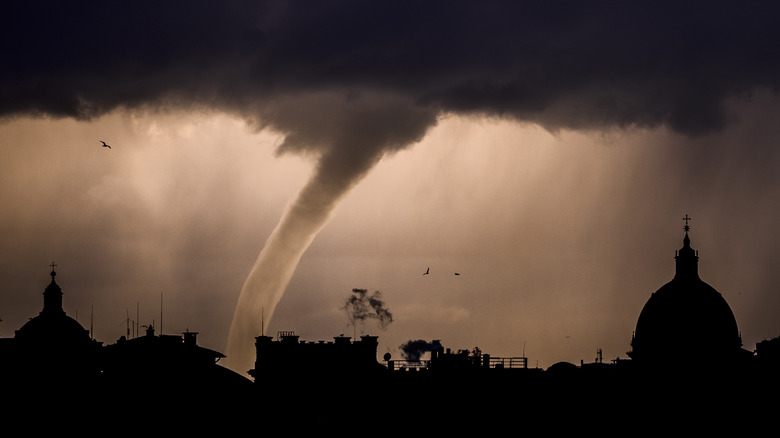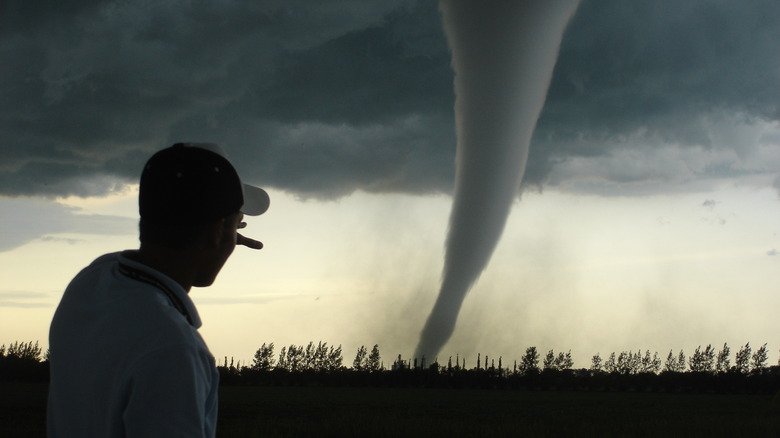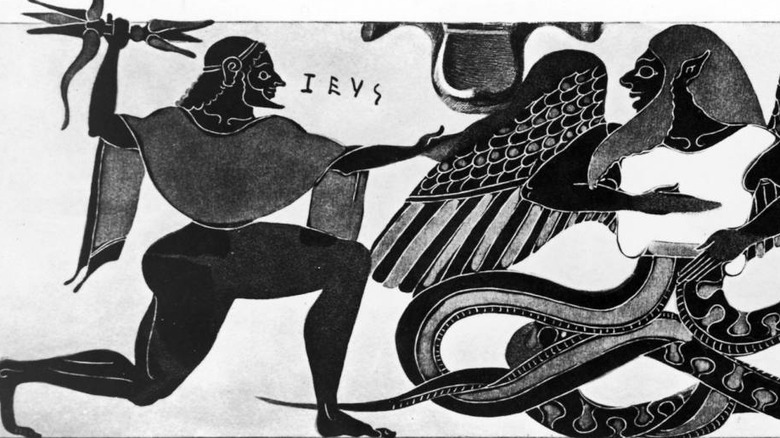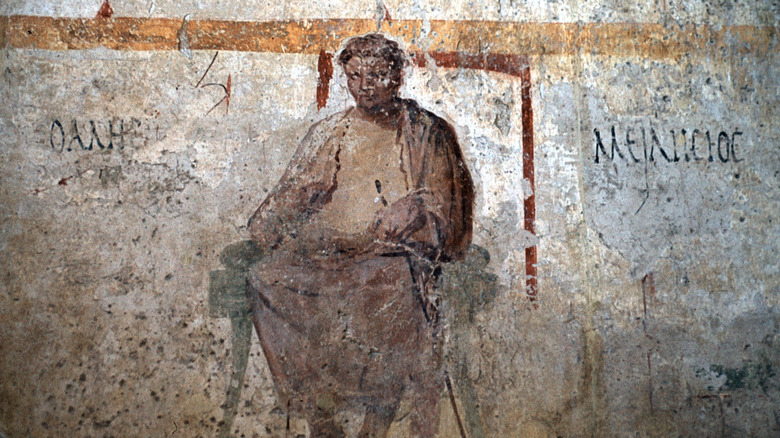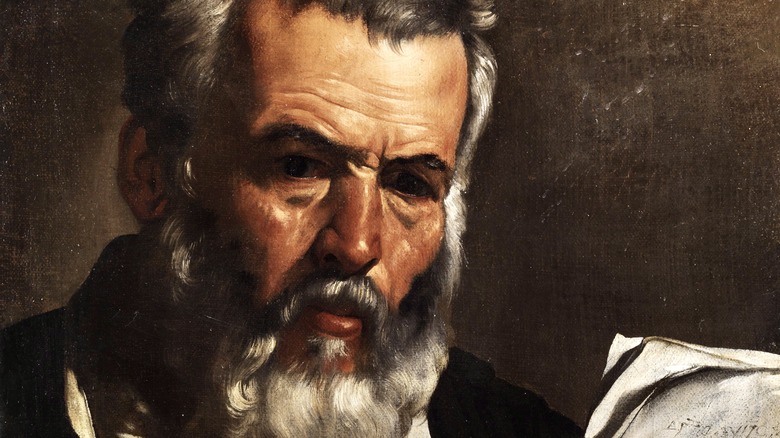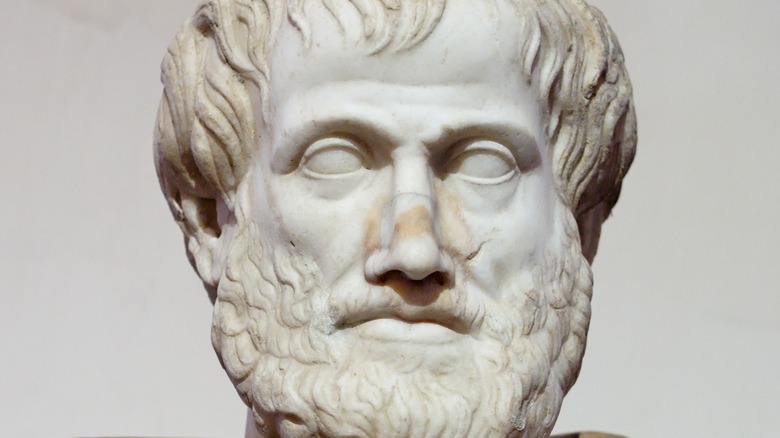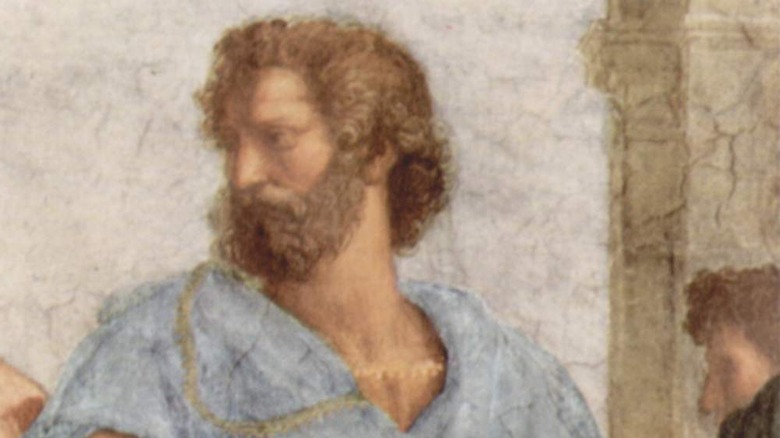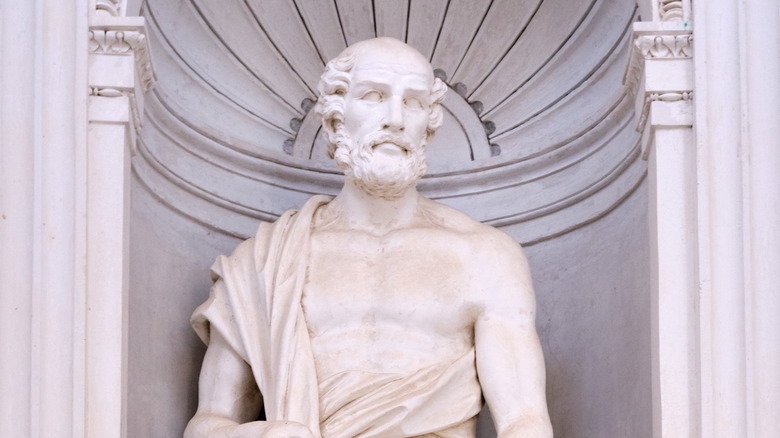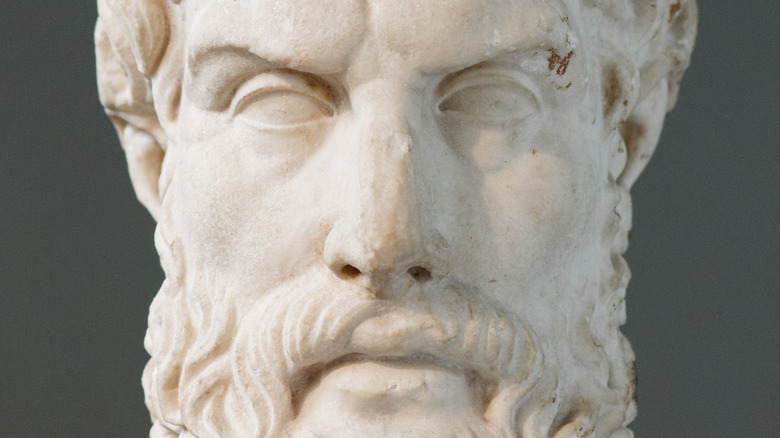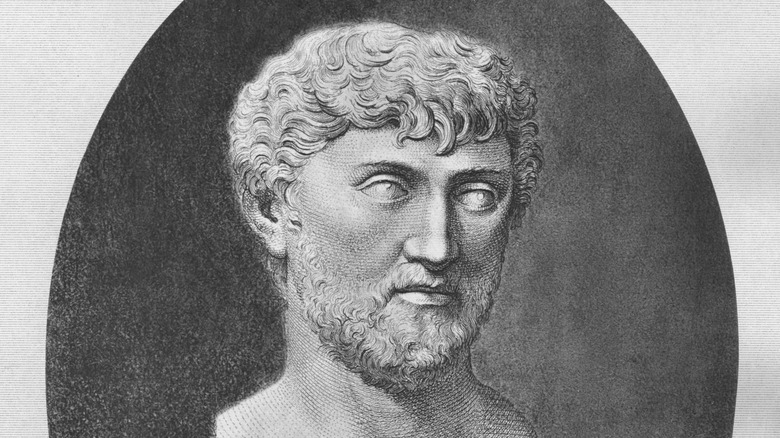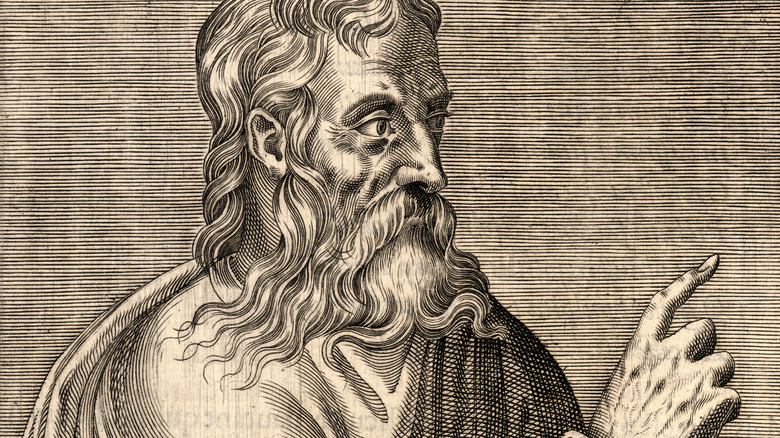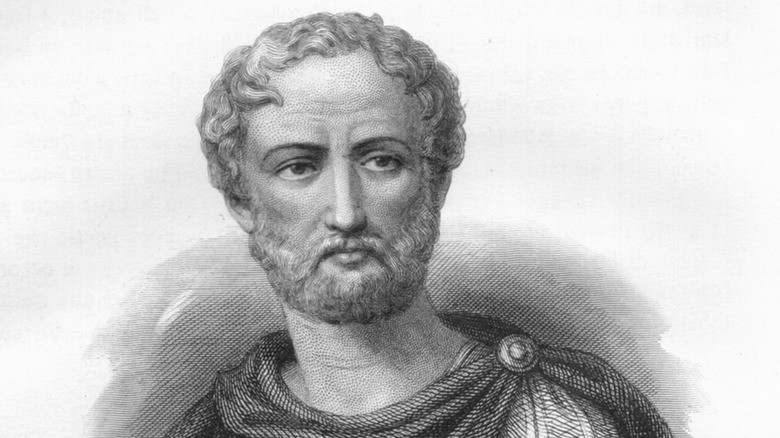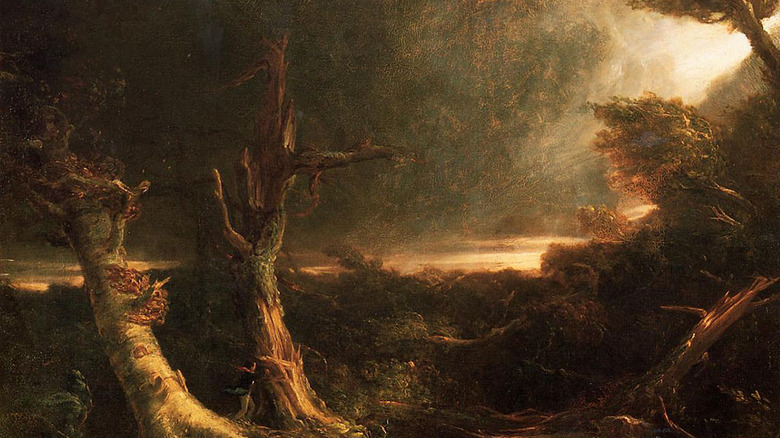Bizarre Theories For Tornadoes In Ancient Rome That People Actually Believed
While most Americans likely associate tornadoes with the corridor across the Plains States commonly known as Tornado Alley, the fact is that tornadoes happen everywhere and have been recorded on every continent except Antarctica. This obviously includes Europe, where such storms are less common than in the U.S., but are hardly an unknown occurrence.
The ancient Greeks and Romans would have definitely been familiar with tornadoes (and their marine equivalent, waterspouts), which they called by names such as turbo, typhon, and ecnephias. For ancient people without modern meteorological equipment, such sudden, violent storms must have been very confusing and terrifying. As the Greeks and Romans attempted to understand these phenomena, they considered some theories that might seem pretty strange to a modern reader. Here is a brief rundown on how the philosophers of ancient Rome understood tornadoes, as well as the Greek philosophers whose work they used as a basis for their own.
How do tornadoes actually form
Before we take a look at the theories behind tornadoes in ancient days before the development of modern meteorology, it's probably best to talk about, you know, how tornadoes actually happen. Obviously, you already know this backward and forwards, so this will just be a review for convenience's sake, ahem. Anyway, while each tornado is different, the majority of them begin as supercell thunderstorms — severe thunderstorms that are formed by the instability created when winds at different altitudes are blowing in different directions or at different speeds, which causes a spinning mass of air called a vortex at its center. This spinning air current begins in a horizontal position, but in the right conditions can become vertical.
As the supercell — which can also produce hail, heavy rains, and strong winds — gets bigger, the vortex column will start to tip over, drawing up warm, moist air from the ground, and pushing cold, dry air downwards. The moisture from the warm air fills the vortex with water vapor, which leads to the creation of a funnel cloud. Meanwhile, the downward movement of cold air both speeds up the funnel cloud and tightens its spiral, while also pushing it down until it touches the ground as a tornado. Depending on the strength of the tornado, it can have a diameter of miles wide, travel at speeds up to 300 miles per hour, and last for hours.
Mythological explanations
As with most natural phenomena, for much of their history, the ancient Greeks and Romans attributed tornadoes and other storms to the will and actions of the gods. Greece and Rome were both heavily agricultural societies, so their dependence on favorable weather meant that they did their best to propitiate the gods of the storm. You probably already know that Zeus (or Jupiter to the Romans) was not only king of the gods, but also the one who controlled lightning, rain, and storms. Homer frequently calls him "cloud-gathering Zeus" throughout his epics. Zeus' brother Poseidon (Neptune to the Romans) was also depicted, as lord of the sea, as being able to control the weather and cause storms with his trident. In the "Odyssey," Poseidon is described as "gather[ing] the clouds, and seizing his trident in his hands troubled the sea, and rous[ing[ all blasts of all manner of winds, and hid[ing] with clouds land and sea alike."
But one mythological being associated with windstorms, in particular, was the serpentine giant Typhon, from whose name we get the word "typhoon," who was conceived of by the ancients as the source of whirlwinds and other destructive wind storms. In the early days of creation, Zeus had a giant battle with Typhon that ended with the king of the gods casting the giant into the Underworld, from which his rages and struggles create wind storms on the earth.
Thales of Miletus
While many ancient Greeks and Romans considered weather and other natural phenomena to be the handiwork of gods and monsters, the Greeks are of course well known for their explorations into science and philosophy, so some Greek scholars are among the first recorded to observe and try to understand meteorological happenings like tornadoes. One of the most significant early philosophers was Thales of Miletus, a mathematician and astronomer of the late 7th/early 6th centuries BCE who was called by some successors (like Aristotle) the father of European philosophy. Unfortunately, none of his writings survive, so all we have left are fragments preserved in quotations by other philosophers.
What we do know about his ideas is that he contrived a cosmology of the universe in which water was the fundamental matter of the universe and that he was a skilled enough astronomer that he was able to predict a solar eclipse with perfect accuracy. His understanding was that all weather phenomena were caused by the movements of the stars and planets. On the surface, this might sound crazy, but when you consider he was the first to observe the solstices and the changing of the position of the sun in the sky over the course of the year in relation to the turning of the seasons, he wasn't actually entirely wrong, per se. But yeah, Mars isn't the reason a tornado smashed your house.
[Featured image by Institute for the Study of the Ancient World via Wikimedia Commons | Cropped and scaled | CC BY 2.0]
Anaximander and Anaximenes
Thales' Milesian school produced a number of others who subscribed to his ideas that nature followed laws that we could study, understand, and predict rather than being due merely to the whims of the gods. Two of the most notable of these students were Anaximander (c. 610–c. 546 BCE) and his student Anaximenes (c. 585–c. 528 BCE), considered to be the star students of Thales. While these two men are thought to be among the first philosophers to actually write their ideas down, most of their writings are preserved today only through the quotations of others, like Aristotle. Unlike Thales, who said water was the basis of all things, Anaximander believed that the world came into being through the interaction and clash of opposite elements in the universe — cold air vs. hot fire vs. moist water vs. dry earth, and so on.
He was among the first to devise a scientific theory for wind, which he said was air flowing when too much air massed together and fine vapors were squeezed out. Thunder comes from clouds smashing together, and lightning comes when wind violently separates clouds. Anaximenes, however, believed that the fundamental element was air, and all other elements were formed out of it through condensation. His understanding of weather was based on air condensing and separating in different ways. In retrospect, he wasn't actually too far off from our modern understanding of the water cycle.
Aristotle
The first philosopher to really question the conclusions of the Milesian school and to try to study weather in a systematic way — and maybe the first philosopher mentioned here that you've heard of — was Aristotle (384–322 BCE), the famous student of Plato and teacher of Alexander the Great. Aristotle wrote a monumental work known as "Meteorologica," which was a multi-volume book that looked at previous theories for weather phenomena and proposed some new theories of its own. There were individual chapters about rain, hail, frost, wind, thunder, and so on. And it's in this work that Aristotle becomes the first ancient Greek to write specifically about tornadoes and waterspouts rather than just about storms and winds more generally.
The beginning of Book III sees Aristotle talking about "hurricanes, typhoons, firewinds, and thunderbolts," but strangely he never uses any real-world examples as the basis for his descriptions. Aristotle says that within the terrestrial sphere, the four classical elements — earth, fire, air, and water — are constantly interacting and transforming into each other, forming two opposing forces he called "exhalations." One of these is wet and cold, the other is dry, hot, and inflammable. The cold exhalation sinks and the warm exhalation rises, and weather is created by the interactions of these exhalations and the movements of the stars in the celestial sphere. For example, small quantities of dry exhalation produce lightning, which Aristotle thought of as fire-like.
Waterspouts and firewinds
In "Meteorologica," Aristotle says that tornadoes, waterspouts, and other wind storms are caused when wind is caught inside a cloud and is struck by winds moving in different directions, which causes it to start to spin in a circular pattern. He never offers an explanation for the vertical descent of the funnel cloud, but he says that it is the sinking of the swirling eddy of air that distinguishes a tornado from other types of wind storms. The sinking wind brings the cloud in which it was trapped down with it, and together the newly formed tornado's "blast overturns anything that lies in its path, and its circular motion whirls away and carries off by force anything it meets." In the broad view, this is actually not a bad understanding of tornado formation compared to how we understand them today. We just have a different view of how air masses of different temperatures are formed.
Less familiar, however, would be Aristotle's conception of what he calls a prēstēr, or firewind, which is a tornado wherein the cloud material is of a fine texture that is thus able to catch fire. Aristotle says that the firewind's "conflagration sets on fire and so colors the neighboring air." As you might imagine, there has been some debate as to what actual phenomenon is being described here, but many interpreters understand it to mean a tornado accompanied by a lightning storm.
Theophrastus
Aristotle was followed as leader of his philosophical school by Theophrastus (c. 371–c. 287 BCE), who used his teacher's "Meteorologica" as the inspiration and basis for a number of much shorter works on the topic of weather, including "On Winds," "Meteorology," and "On Weather Signs." While Aristotle used his idea of exhalations as a single cause for more or less all weather phenomena, Theophrastus saw them as only one of a number of explanations. For example, he did not attribute winds to interactions between exhalations, but rather to air moving to correct an imbalance caused by the heat of the sun.
He offered two different explanations for tornadoes. The first was that tornadoes and waterspouts occurred when a hollow cloud began to move higher in the air and dragged wind along with it, a process that stretched the cloud from the sky to the ground or the sea and formed what we would call a funnel cloud. His second explanation was closer to Aristotle's, wherein tornadoes form when wind rushes off a cloud.
In his work "On Weather Signs," Theophrastus suggests that you can predict a tornado is coming if your feet swell up, if you feel a shooting pain in your right foot, or if you see a hedgehog blocking up both the northern and southern entrances to his den.
Epicurus
While the Greek philosopher Epicurus (341–270 BCE) is most associated these days with the pursuit of pleasure thanks to evolving definitions of the word "epicurean," the historical Epicurus was heavily concerned with topics of both ethics and the natural world, not eating fancy food. A central premise of Epicurean ethics is that the primary goal of life should be the elimination of fear, including the fear of the gods and death. As a result, much of his pursuit of the study of the natural sciences was to present rational explanations for natural phenomena and eliminate superstitions that lead to fear. This, of course, included weather. Epicurus thought if he could persuade people that storms were caused by understandable, predictable reasons, they would no longer fear that they were the whim of angry gods.
In Epicurus' "Letter to Pythocles," he presents two explanations for tornadoes: in the first, tornadoes form when wind is caught inside a cloud and pushes it down until it forms a pillar shape, and then external winds strike it horizontally, causing the spinning motion. This explanation is pretty similar to Aristotle's. The second explanation doesn't require a cloud to begin; he suggests that wind just moves in a circle sometimes when it's high enough. This wind circle becomes visible when it is struck by condensation from the atmosphere, which also drives the wind pillar downward.
Lucretius
While the Greeks in the ancient period didn't write down a record of any specific tornadoes occurring, the Romans definitely did. The earliest recorded tornado in Roman history occurred in 152 BCE in the Campus Martius, where it destroyed a column topped by a gold statue of Jupiter at a nearby temple. A tornado in 60 BCE is said to have destroyed houses, torn up trees, and smashed a bridge. This particular windstorm could possibly have been witnessed by the Roman philosopher Lucretius (c. 99 – c. 55 BCE), whose only known work is the massive philosophical poem "De Rerum Natura" ("On the Nature of Things"), which presents the ideas of the Greek Epicurean school for a Roman audience.
In Book VI of "De Rerum Natura," Lucretius explains two possible causes for the creation of tornadoes, trying, like Epicurus, to remove superstitious fear of them. His first explanation is essentially the same as Aristotle's, with violent wind trapped inside a cloud that it then pushes down to the ground or sea. The second explanation centers more on Lucretius' idea of the universe being made up of atoms and void. In this theory, a swirling wind flies through the clouds and gathers up the "seeds" (i.e., atoms) of clouds until it falls to the earth or sea, bursts open, and belches out a big ol' tornado.
Seneca the Younger
About 100 years after Lucretius, the Roman philosopher Seneca the Younger (c. 4 BCE–65 CE) put forth his ideas about the causes of meteorological phenomena. Seneca was a Stoic, not an Epicurean, so he didn't have the same interest as Epicurus and Lucretius in freeing people from fear; he just thought the natural world was cool and he wanted to know about it. Shortly before his death, he wrote a beefy seven-volume work filled with his theories on cosmology and weather and such called "Naturales Quaestiones" (literally "Natural Questions," but in the sense of like "investigations into nature"). Seneca wrote about winds, and specifically tornadoes and waterspouts, in Book V of this work.
In his discussion on wind storms, he imagines wind moving in streams much like water moving along a river. When flowing water hits an obstacle like a rock or a tree, it gets deflected and starts to whirl around. Likewise, Seneca posited that wind would fly free and in a straight line as long as nothing was blocking it. But when it bumped into something or got squeezed through a tight pathway, it starts to whirl around on itself until it forms a vortex. As the vortex spins around on a single spot and works itself up into a fury, it becomes a tornado. If the tornado lasts long enough, it will eventually catch fire and become a prester, as Aristotle wrote.
Pliny the Elder
Another Roman writer from the first century CE was the naturalist Pliny the Elder (23–79 CE), who wrote an absolutely monumental work called the "Natural History," which was basically an early version of an encyclopedia. This monster work discusses just about everything under the sun, including astronomy, zoology, geography, and horticulture, so obviously it also touches on meteorology. Pliny hoped to understand the causes of meteorological phenomena so he could reliably predict them, something that would be very useful for damaging storms like tornadoes.
In Pliny's estimation, there were two types of winds: normal, steady winds, and sudden, gusting winds. The causes for this latter type of wind come from the dry exhalations of the earth, or else from vapors from bodies of water that are pushed into a streaming current by the rays of the sun. As you might guess from his use of the term "exhalations," his ideas on the formation of tornadoes are pretty similar to Aristotle's. More interesting, however, are his thoughts on how to prevent tornadoes. He believed that tornadoes couldn't stand exposure to cold, so you could partially deflect a tornado by splashing it with vinegar, which he considered very cold. For this same reason, he claimed that a tornado could never form from a north wind and that they could never touch down when it was snowing.
Julius Obsequens
Many of the surviving reports of tornadoes in ancient Rome come from an author from the late Roman Empire, writing in the 4th or 5th century CE, named Julius Obsequens. The only extant work by Julius is a collection of strange disasters and catastrophes that were subsequently interpreted as omens of ill fortune. This book is called the "Book of Prodigies," and since Julius was writing about events in the Roman Republic and early Empire centuries before his time, he was obviously not an eyewitness, but rather used the work of the 1st century CE historian Livy as his major source.
The "Book of Prodigies" records the tornado in the Campus Martius that tore down the pillar of Jupiter, which Julius claims was a warning that many magistrates would die, which caused all the magistrates to resign. He likewise records that in 44 BCE a tornado knocked over a statue erected by the statesman Cicero and broke off its head and hands, an ill omen for Cicero's own assassination following the death of Caesar in which his head and hands were cut off. That same tornado ripped bronze plates inscribed with the law from the temple of the Roman god Fides, predicting the lawlessness that would ensue in the civil war between Augustus and Marc Antony. So in one sense, Julius Obsequens' writings see tornadoes once again become the tools of the gods, in this case as divine warnings.
